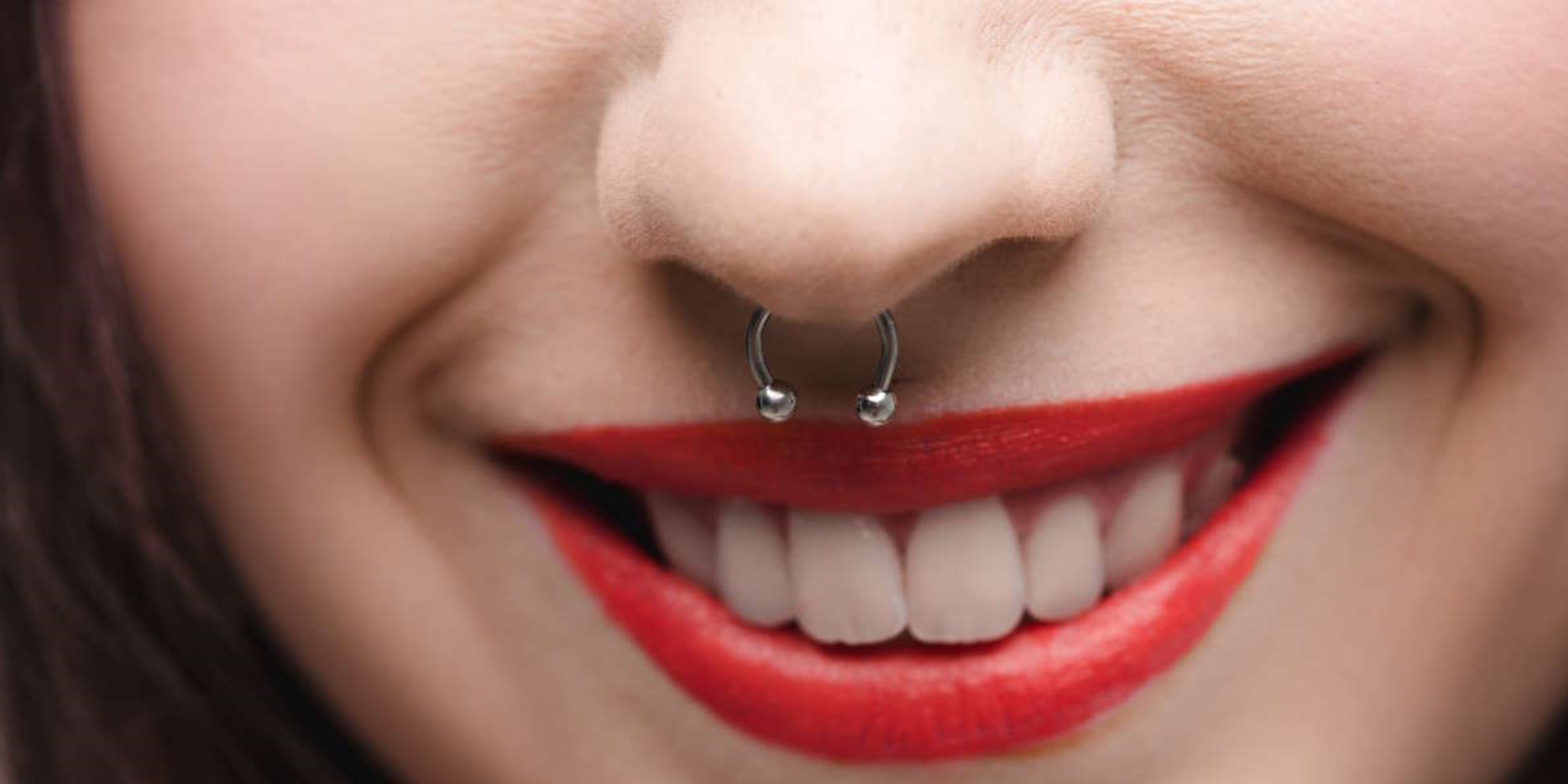
Join The Piercing Ya Newsletter
Septum Piercing: A Guide To In Between The Nostrils
Septum Piercing Article Quick Reference:
History | Myths | Complications | Pain | Cost | Procedure | Healing | Aftercare | Jewelry | Celebrities
The septum piercing is located in the nasal septum, which is the thin strip of skin and cartilage separating the nostrils. It’s important to note, however, that the actual piercing does not go through the cartilage itself. Instead, the piercing is typically done through the “sweet spot”, a thin and flexible area of flesh just below the cartilage. This spot varies in size from person to person but is generally found towards the front bottom part of the septum.
The diagram below gives you a visual idea of where the septum is located.
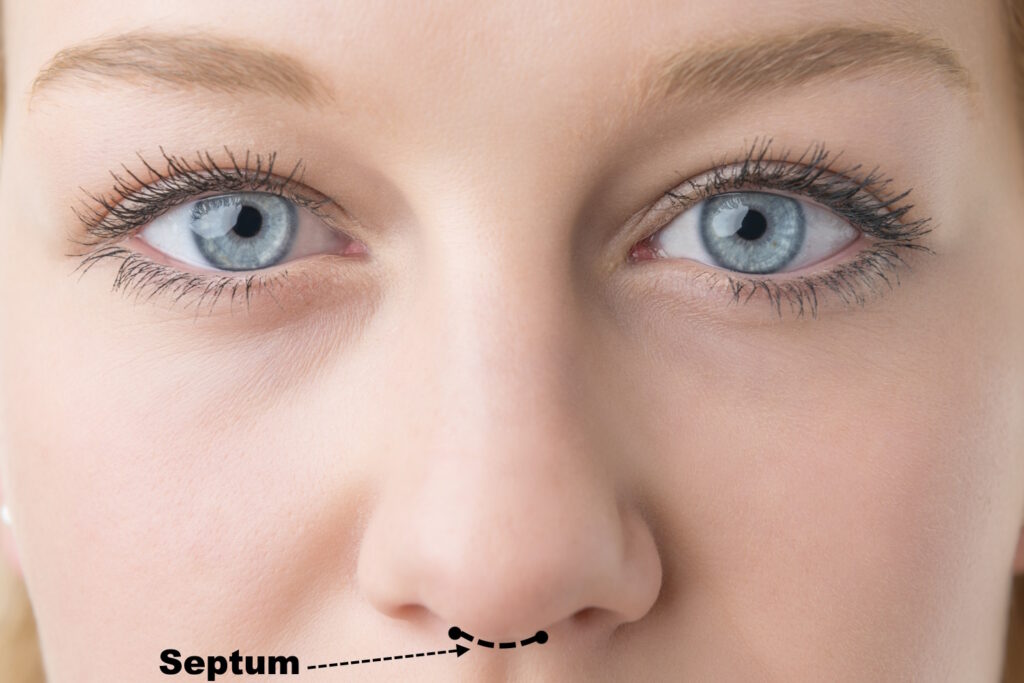
HISTORY OF THE SEPTUM PIERCING
The septum piercing has a rich and diverse history that spans continents and cultures. Its origins can be traced back to various ancient civilizations, with each attributing different cultural and spiritual significance to the practice.
In many indigenous cultures, the septum piercing played a pivotal role in societal and spiritual customs. For instance, among the Asmat tribe of Irian Jaya, Indonesia, it signified a young boy’s transition into manhood. The pierced septum was adorned with bone or tusk, symbolizing this critical life transformation.
The practice was also prevalent among native tribes in North and South America. The warrior castes among the Aztecs, Mayans, and Incas sported septum piercings, often wearing large and ornate jewelry as a symbol of strength and bravery. In North America, the Tlingit and Haida tribes of the Northwest Coast viewed septum piercings as an emblem of social status.
The septum piercing has held spiritual significance as well. In India, it has been customary for certain Hindu women to wear a septum ring, known as a “Bulak,” after marriage, believed to make childbirth easier due to certain acupuncture points in the area. This practice is still prevalent in some rural parts of India.
During the 1900’s to 2000’s, septum piercings were associated with counter-culture movements like punk and goth. They weren’t widely accepted in Western societies until the early 2000s when they gradually became a popular trend among alternative culture groups.
In recent years, septum piercing has become a mainstream fashion trend. Social media and the influence of celebrities who have gotten their septum pierced have significantly contributed to its surge in popularity.
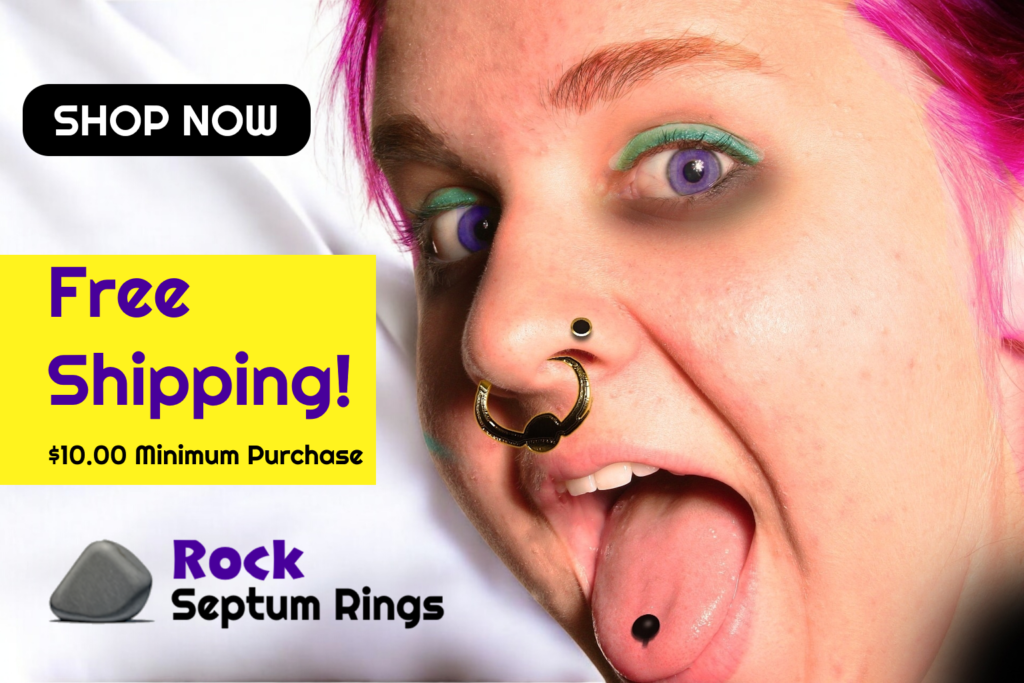
DEBUNKING THE WORRISOME MYTHS
While septum piercings have grown in popularity and acceptance, they remain shrouded in a veil of myths and misconceptions that can often deter individuals from getting one. Read about some of these below:
- Septum Piercing Always Hurts A Lot: Pain is subjective and varies greatly from person to person. Some people report the septum piercing to be painful due to the sensitivity of the area, while others feel only a brief discomfort. The procedure is typically swift, which helps minimize any pain.
- The Piercing Goes Through Cartilage: Many people believe that the septum piercing involves puncturing the nasal cartilage, but this is not the case. Piercers aim for the “sweet spot” – a thin strip of skin found just in front of the cartilage.
- Septum Piercings Will Permanently Alter Your Nose: There’s a common myth that septum piercings will stretch or disfigure your nostrils over time. This is untrue. Once healed, even if you decide to remove the jewelry, the hole tends to close up and become barely noticeable.
- Septum Piercings Are Unprofessional Or Unattractive: Beauty and professionalism are subjective. While septum piercings might have once been seen as edgy or alternative, they’ve gained widespread acceptance in many professional and social settings. Furthermore, there’s a range of jewelry styles available to fit different personal aesthetics and professional contexts.
- You Can’t Hide A Septum Piercing: Contrary to this belief, septum piercings are among the easiest to conceal when needed. By simply flipping the jewelry upward into the nostrils, the piercing can be completely hidden. This is especially easy with certain styles of jewelry, like septum retainers or horseshoe rings.
While these myths can often cloud our understanding and perception of such a body modification, it’s crucial to separate fact from fiction.
WHO WEARS A SEPTUM PIERCING THE MOST?
Among men, septum piercing has become a popular choice in the realm of body modification. The piercing’s association with strength and bravery in ancient cultures adds a certain allure, and the ability to conceal the piercing when necessary makes it a versatile option.
Women have equally embraced this piercing. This piercing can range from bold and dramatic to subtle and delicate, depending on the style and size of jewelry chosen, making it a versatile accessory that can be tailored to the wearer’s personal style.
As far as age goes, it is most common among individuals in their late teens to mid-thirties. This age range represents a time when personal style and self-expression are often heavily explored, and body modification such as piercings can be a part of that exploration.
As much as many younger folks want a septum piercing, in many places, the minimum age to get one without parental consent is typically 18 years old. This age restriction is in place to ensure that individuals are mature enough to make informed decisions about body modifications and understand the potential risks and aftercare requirements.
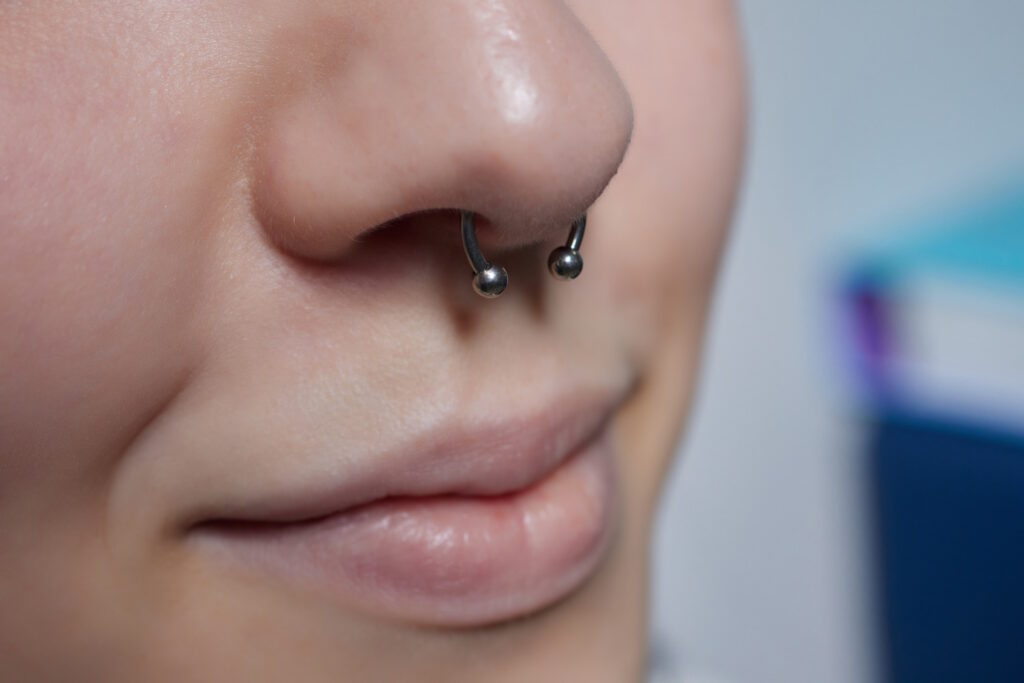
WATCH OUT FOR THOSE RISKS
Some of these risks are common to all piercings, such as infection, allergic reactions, or scarring, while others are more specific to the location and nature of the septum piercing. See some of these below:
- Infection: This is a common risk with any form of body modification. The septum may become infected if it’s not properly cleaned and cared for, or if the procedure wasn’t done in a sterile environment. An infected septum may become swollen, red, and painful, and it may discharge pus.
- Incorrect Placement: If the piercing is not done by a skilled and experienced professional, it may not be placed correctly. Incorrect placement can lead to unnecessary pain, prolonged healing times, and asymmetrical appearance.
- Rejection Or Migration: Sometimes, the body rejects piercings, causing them to slowly migrate out of the tissue over time. This process can result in scarring and possibly the need for corrective procedures.
- Allergic Reaction: Some people may be allergic to certain materials used in the jewelry for the piercing, such as nickel. This can cause irritation, redness, swelling, and other allergic reactions.
- Nerve Damage: Though rare, there’s a risk of damaging a nerve during the piercing process. This could lead to numbness or changes in sensation around the pierced area.
- Septal Hematoma: This is a collection of blood within the septum, which could result from the piercing procedure. If not treated, it can lead to complications like a septal abscess or a deviated septum.
- Endocarditis: This is an inflammation of the heart’s inner lining, typically as a result of bacteria entering the bloodstream during the piercing procedure. This is a rare but serious complication.
Most of these risks can be minimized through proper hygiene, careful choice of a licensed and experienced piercing professional, appropriate aftercare, and selection of suitable piercing materials.
AND WE CAN’T FORGET ABOUT COMPLICATIONS
Before deciding to get a septum piercing though, there are also several health considerations to take into account:
- Immune System Health: Your body’s immune system plays a crucial role in healing any type of wound, including a piercing. If you have a compromised immune system due to conditions like HIV, diabetes, or are undergoing treatments like chemotherapy, your body might take longer to heal or might be more susceptible to infections.
- Current Health: If you’re currently fighting an infection or are feeling unwell, it might be best to wait until you’re healthy before getting a piercing. Your body needs to be at its best to heal the piercing quickly and effectively.
- Blood Disorders: Those with blood clotting disorders, such as hemophilia, should consult their doctor before getting a piercing as these conditions may lead to excessive bleeding during and after the procedure.
- Use of Certain Medications: Some medications, particularly those that thin the blood like aspirin or certain types of anti-inflammatory drugs, can increase the risk of bleeding during the piercing process. Be sure to discuss any medications you’re taking with the piercing professional.
It’s essential to seek advice from a qualified piercing expert and, when appropriate, your healthcare professional if you have any pre-existing conditions prior to obtaining a septum piercing or any other type of body modification.
TO HAVE AND TO HOLD, UNTIL YOU DON’T
A septum piercing can be reversed in the sense that you can remove the jewelry and allow the piercing hole to close. However, how completely it heals can depend on several factors.
- A newer piercing is more likely to close up than one that’s been in place for a long time.
- Smaller gauge jewelry tends to leave smaller holes, which may close more completely than larger ones.
- Everyone’s body heals differently, and some people might find that their piercing closes quickly and completely, while others might always have a small hole.
- Just like when you first get the piercing, keeping the area clean after removing the jewelry is important to prevent infection and aid healing.
Even if the hole does close completely, you may have a small scar. However, because of the location of a septum piercing, this scar is usually not visible.
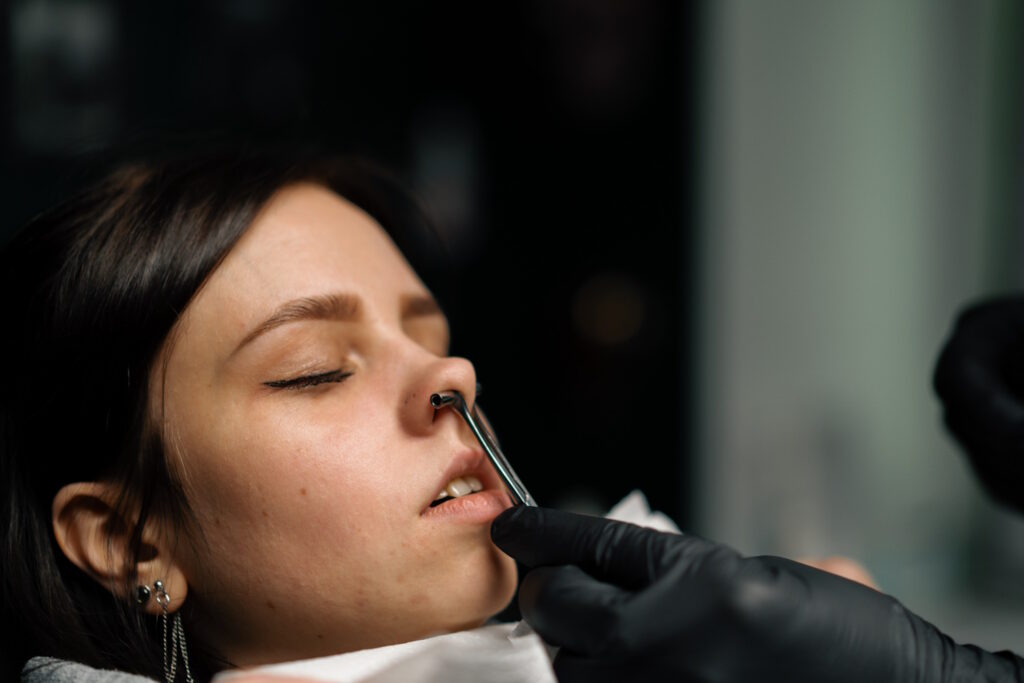
HOW PAINFUL IS THE SEPTUM PIERCING?
Thinking about getting a septum piercing? Wondering how bad it hurts? Well, let me spill the beans. Truth be told, pain levels can vary from person to person, but I’ll give you the lowdown on some general pain management techniques that might help take the edge off. Check out the items below for some sweet pain-easing tips:
- Numbing Creams: Slap on a numbing cream like lidocaine before your piercing to numb the area and reduce discomfort.
- Ice It Up: Apply an ice pack or ice cubes wrapped in a cloth to the area before and after the piercing to numb the pain and keep swelling at bay.
- Deep Breaths: Take slow, deep breaths during the piercing process to relax and distract yourself from the pain.
- Over-The-Counter Painkillers: Pop some ibuprofen or acetaminophen (as directed!) before the piercing to help reduce inflammation and alleviate pain afterward.
- Mind Over Matter: Channel your inner zen and focus on positive thoughts or engage in calming activities like listening to music or chatting with the piercer to distract yourself from the pain.
- Proper Aftercare: Following a strict aftercare routine, including regular cleaning can help minimize pain.
So, don’t fret too much about the pain, my friend. There are plenty of pain management techniques you can try to make your septum piercing experience a bit more bearable.
SEPTUM PIERCING: NOSE JOBS AREN’T CHEAP
Ready to dive into the world of septum piercings and get the scoop on the price tags? Well, hold onto your nose rings, because I’m about to break it down for you. Prices can vary depending on where you’re located, so let’s get geographical and explore the approximate costs across different regions of the US. Here’s the lowdown on prices in the following areas:
- East Coast (e.g., New York City, Boston, Washington D.C.):
Average range: $40-$80
Upscale studios: $80-$150 - Midwest (e.g., Chicago, Minneapolis, St. Louis):
Average range: $30-$60
Budget-friendly options: $20-$40 - South (e.g., Atlanta, Miami, New Orleans, Dallas):
Average range: $30-$60
Some studios may offer discounts or package deals. - West Coast (e.g., Los Angeles, San Francisco, Seattle):
Average range: $50-$90
Trendy studios in metropolitan areas: $90-$150
Keep in mind that these prices are approximate and can vary depending on factors like the reputation of the piercing studio, the experience of the piercer, and the quality of jewelry used. Make sure to do your research, check out reviews, and find a reputable piercing studio near you. Remember, it’s not just about the cost—it’s about finding a skilled piercer who will make your septum piercing experience a safe and awesome one.
SEPTUM PIERCING: FROM PREP TO POKE
But before you go running to the nearest piercing studio, let’s break down the septum piercing procedure so you know what to expect. Ready? Let’s do this!
Step-by-step guide to getting a septum piercing:
- Consultation: Once you’ve found your dream studio, schedule a consultation to discuss your piercing. The piercer will assess your anatomy, answer any questions you have, and help you choose the perfect jewelry.
- Prepping The Area: On the big day, the piercer will clean and sanitize the area around your septum. They might use an antiseptic solution or a sterile wipe to ensure everything is squeaky clean.
- Marking The Spot: The piercer will use a surgical pen to mark the entry and exit points of the piercing. Take a deep breath and trust their expertise—it’s all part of the process.
- Numbing (Optional): If you’re nervous about the pain, you can request a numbing cream. The piercer will apply it to the area, and you’ll wait a bit for it to take effect.
- Piercing Time: Get ready! The piercer will use a sterilized needle to create the piercing hole. Take a deep breath and stay as still as possible. You might feel a sharp pinch or a slight burning sensation, but remember, it’s over before you know it!
- Inserting The Jewelry: Once the piercing is done, the piercer will gently insert the chosen jewelry, typically a captive bead ring or a circular barbell. They’ll make sure it’s secure and sits properly in your septum.
- Aftercare Instructions: The piercer will provide you with detailed aftercare instructions. Follow them religiously to keep your new piercing clean and happy.
Remember, finding a skilled piercer and following proper aftercare instructions are crucial for a successful piercing.
A SNOT SO FAST HEALING TIME
Let’s talk about the healing process for your awesome septum piercing. Now, listen up, ’cause this is important. Healing times can vary from person to person, but I’ll give you the general lowdown so you know what to expect.
First off, let’s talk about the initial healing phase. After getting your septum piercing, you might experience some swelling, tenderness, and redness around the piercing site. Don’t freak out—it’s totally normal! During this phase, which lasts around 4 to 6 weeks, your body is working hard to heal that fresh hole in your septum.
Now, brace yourself for the long haul—because we’re heading into the second phase of healing. This bad boy usually lasts around 6 to 8 months. During this time, you might notice that the swelling goes down, and the redness subsides. However, don’t get too comfy just yet. Your septum piercing is still a work in progress, my friend. Keep up with your aftercare routine, be patient, and don’t rush the process.
Last but not least, let’s talk about full healing. This is the final stretch, the moment when your septum piercing is ready to party like a rockstar. This phase can take anywhere from 8 to 12 months or even longer, depending on your body’s healing speed.
So, my piercing enthusiasts, remember that healing times can vary, and everyone’s body is unique. Be patient, stay committed to your aftercare routine, and if you have any concerns, don’t hesitate to reach out to your piercer. Now, go forth, embrace the healing process, and get ready to rock that healed septum piercing with style!
AFTERCARE: MINDING YOUR NOSE BUSINESS
Now that you’ve got that sick new piercing, it’s time to talk aftercare. Follow these aftercare tips for your fresh septum piercing:
- Clean It Up: Use a saline solution or a saltwater mixture to gently clean your piercing twice a day. Dab it on with a cotton ball or a clean cloth, and make sure to rinse off any excess solution. Keep that bad boy clean and infection-free!
- Hands Off: Resist the urge to touch or play with your piercing, my friend. Your hands may be clean, but germs and bacteria can still hitch a ride. So, keep those fingers away and let your septum piercing heal in peace.
- Be Gentle: When drying your piercing after cleaning, use a clean, disposable paper towel or let it air dry. Avoid using towels or fabrics that may harbor bacteria. Remember, a gentle touch goes a long way.
- Avoid Irritants: Stay away from harsh chemicals, makeup, perfumes, and hair products that might irritate your piercing. Your septum needs some breathing space, so give it the love it deserves.
- Say No To Taking A Dip: Sorry to be the party pooper, but it’s best to avoid swimming pools, hot tubs, and bodies of water during the initial healing period. Chlorine and bacteria can be a real buzzkill for your healing septum.
Taking care of your septum piercing is essential for a smooth healing journey. By following these general aftercare tips, you’ll be on your way to rockin’ that rad septum piercing in no time.
THE JEWELRY SWITCHEROO
Ready to level up your septum game and change that jewelry? Well, changing your septum jewelry isn’t something you should rush into. You gotta give your piercing ample time to heal first. On average, it takes around 6 to 8 weeks for initial healing, but remember, everyone’s body is different. So, here are a few signs that your piercing may be ready for a jewelry switcharoo:
- No More Pain Or Tenderness: If your septum piercing has stopped giving you grief and feels comfortable, it might be a good indication that it’s ready for some new bling.
- Reduced Swelling: If the initial swelling has gone down significantly, it’s a positive sign that your piercing is healing nicely.
- No Signs Of Infection: If you don’t see any signs of infection, such as excessive redness, pus, or extreme sensitivity, your piercing might be good to go.
Let’s move on to some tips for changing your septum jewelry for the first time:
- Be Patient: Changing jewelry for the first time can be a bit nerve-wracking, so take your time and don’t rush the process. It’s better to be cautious and thorough than to risk causing any unnecessary irritation or pain.
- Cleanse Your Hands: Before handling your jewelry, make sure to thoroughly wash your hands with soap and warm water. You don’t want any nasty bacteria or dirt coming into contact with your freshly healed piercing.
- Be Gentle: When removing or inserting jewelry, be gentle and avoid excessive pulling or tugging. Slow and steady wins the race. Take your time and ensure a smooth transition.
Remember, if you’re unsure or uncomfortable changing your septum jewelry by yourself, it’s always a good idea to seek help from a professional piercer. They have the experience and expertise to guide you through the process safely.
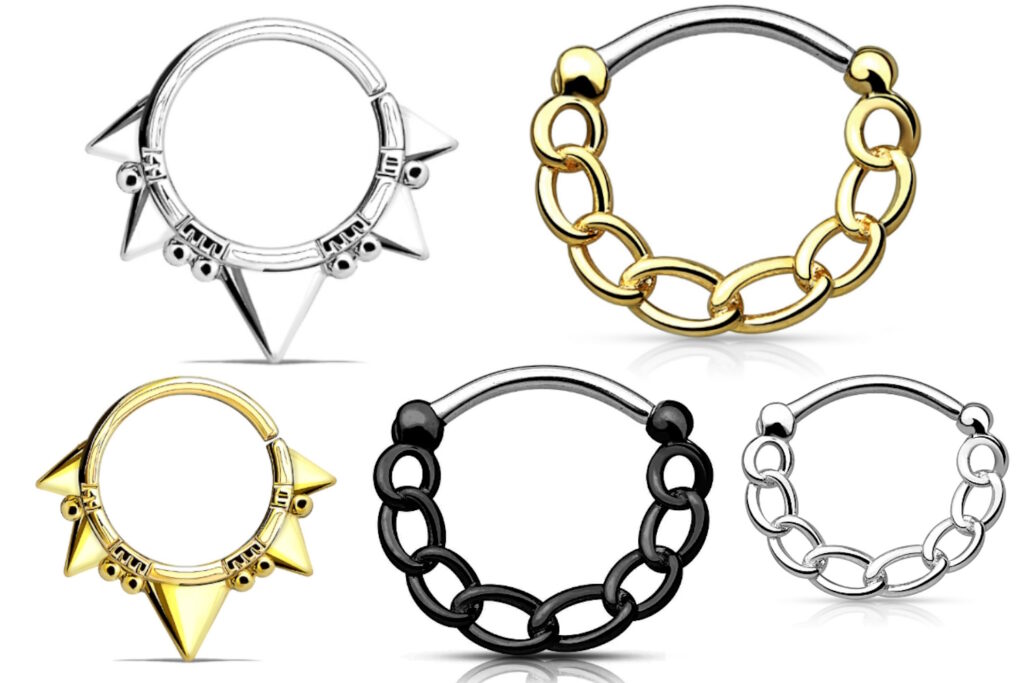
SEPTUM JEWELRY: FROM BASIC TO BOUGIE
When it comes to choosing the right jewelry for your septum piercing, you want to rock the best materials that will keep your piercing happy and looking fab. So, let’s dive into the world of septum jewelry materials and styles. Get ready for the lowdown on what materials to choose and what jewelry styles to wear!
Here are the types of jewelry materials best suited for your septum piercing:
- Surgical Steel: This popular option is known for its durability and hypoallergenic properties. It’s a safe bet for most people and comes in a variety of styles, making it a go-to choice.
- Titanium: If you have extra-sensitive skin or allergies, titanium is your new BFF. It’s lightweight, corrosion-resistant, and ideal for those with metal sensitivities.
- Gold: For those who want to add some luxury to their septum game, gold jewelry is a winner. Opt for high-quality, nickel-free gold like 14K or 18K, which is less likely to cause irritation.
- Niobium: This lesser-known metal is gaining popularity among the piercing community. It’s hypoallergenic, lightweight, and available in various vibrant colors. Plus, it’s just plain cool.
SEPTUM JEWELRY DESIGNS
Now for some styles of jewelry to rock in your septum piercing:
- Captive Bead Rings: Classic and versatile, captive bead rings feature a small bead that is held in place by the ring’s tension. They come in different sizes and designs, allowing you to express your unique style.
- Circular Barbells: These horseshoe-shaped beauties add a touch of edginess to your septum piercing. They feature two beads that screw onto the ends, giving you the flexibility to change up the look.
- Septum Clickers: If you’re all about convenience and style, septum clickers are where it’s at. With a hinged design, they easily snap into place, creating a seamless and stunning look.
- Retainers: Need to keep things low-key or hide your piercing temporarily? Retainers are your secret weapon. These clear, flexible pieces slide right into your septum, giving you the ultimate incognito mode.
Remember to listen to your body and make sure you’re comfortable with the jewelry you choose. So, get out there, have fun exploring different materials and styles, and rock that septum piercing with confidence and style!
CELEBRITIES ROCKIN SEPTUM PIERCINGS
If you’re looking for some celebrity inspiration for your septum piercing, you’ve come to the right place. Celebrities are known for pushing the boundaries of style, and septum piercings have definitely made their mark on the red carpet and beyond. So, buckle up and get ready to dive into the world of famous faces rocking septum piercings like absolute bosses!
These celebrities include the following:
- Rihanna: This iconic singer and fashion mogul isn’t afraid to rock a septum piercing with confidence. Rihanna’s edgy style takes her septum game to a whole new level.
- Jaden Smith: The multi-talented actor and musician, Jaden Smith, embraces his individuality with a septum piercing that adds a touch of rebellious flair to his style.
- Lenny Kravitz: The rockstar himself, Lenny Kravitz, proves that septum piercings are timeless. His badass image is amplified by his pierced septum, adding an extra dose of rock ‘n’ roll to his look.
- Lady Gaga: Never one to shy away from bold fashion choices, Lady Gaga has been spotted rocking a septum piercing, showcasing her fearless and avant-garde style.
- Ruby Rose: The talented actor and model, Ruby Rose, embraces her androgynous style with a septum piercing that adds a touch of rebelliousness and individuality to her overall aesthetic.
- Willow Smith: Following in her brother Jaden’s footsteps, Willow Smith rocks a septum piercing with confidence and showcases her unique personal style.
- Lizzo: Known for her empowering music and vibrant personality, Lizzo’s septum piercing adds an extra touch of fierceness to her already incredible stage presence.
These celebrities prove that septum piercings can elevate any style and add a touch of personality and edge to your look. Remember though, while celebrities can be a source of inspiration, it’s important to embrace your own unique style and make choices that align with your personality.
SEAL THE DEAL WITH A SEPTUM PIERCING?
And there you have it, my piercing enthusiasts! We’ve journeyed through the wild and wonderful world of septum piercings in all its glory. From the pain management techniques to the healing process, aftercare tips, and even some celebrity inspiration, you’re armed with the knowledge to rock that septum piercing with confidence. But remember, the most important thing is to have fun and express yourself through your unique style. Whether you’re opting for a subtle and dainty ring or going all out with a bold clicker, embrace your individuality and wear your septum piercing like a badge of honor. So, go forth, my fearless friends, and let your septum bling shine bright.
Need to find a piercer? Check out the Association of Professional Piercers.
Author: Scott S.
